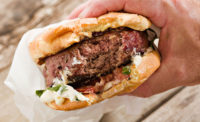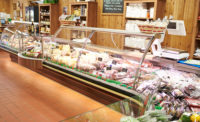A person would be forgiven if they confused a grocery store deli for a fast-casual restaurant or vice versa. Prepared foods, grab and go, hot and cold tables — these are all necessary components of a successful deli today.
“Restaurants are also looking at ways to remodel,” says Dave Donnan, A.T. Kearney partner and global leader of the firm’s Food and Beverage Practice, based in Chicago, to better emulate the trend-setting retail deli stations.
“Deli is the fastest growing perimeter department, up nearly 5 percent in dollars vs. year ago,” says Sarah Schmansky, director for the Chicago-based Nielsen’s Perishables Group. “Convenience and innovative products continue to be key in deli growth, with the majority of growth stemming from deli prepared, which makes up 58 percent of the department and grew 6 percent vs. year ago,” according to data from Nielsen Perishables Group, the last 52 weeks ending May 28.
According to Schmansky, all categories within deli prepared saw dollar growth as well, with several growing in the double digits (sushi, up 13.8 percent; deli soups, up 12.4 percent; and deli breakfast foods, up 10.4 percent).
“Deli prepared is certainly an important area for retailers,” she says. “From 2011 to 2015, the category grew 38 percent and is still growing. Providing both grab-and-go and made-to-order behind the counter options allows consumers the best of both worlds — convenience and freshness.”
The deli counter is clearly going through a transformation, albeit a positive one. “The traditional service center deli is moving toward prepared foods or even to a restaurant within the store, which is becoming much more important to the retail environment,” says Donnan.
Over the next three to five years, Donnan predicts 25 percent to 50 percent of all retail delis will remodel to better accommodate consumers’ desire for fresh, convenient foods.
But do prepared foods stations apply to all grocery stores? “No, it depends on the neighborhood and type of store,” says Donnan. “A high-end store like Wegmans or Mariano’s serves meals with seating and has wine bars, so they are not just grab and go.”
Whereas a value-level store may profit more from sandwiches, soup and salads, he says.
“Every store is changing but in different degrees,” says Donnan.
Focusing on fresh
Recent trends are having a fundamental impact on delis, beyond store design. For one, delis are becoming fresher, offering fewer processed and artificial ingredients with their foods.
“The deli is seen as healthier than restaurant food, because [restaurant] food is perceived as higher calorie, more salty,” says Donnan.
Consumers also are grazing more with their meals — and shopping habits. “They are not buying a week’s worth of groceries anymore,” says Donnan. “Food is bought ad hoc; it’s more grab and go.”
Household makeups are helping these trends, as they tilt toward fewer families and more singles, he says. These shoppers are more likely to shop multiple times a week for fewer items.
The deli and prepared food sections can continue growing through retailers promoting the section across the store experience, says Colleen McClellan, director at Datassential in Chicago.
McClellan says other areas of opportunity for expanding growth among deli and prepared food sections are by:
- Sharing the store’s food story with shoppers, noting when an item is made from scratch or uses a local brand or flavor
- Offering both full-meal solutions and snacks for easy grab and go to consume on or off premise
- Adding the element of personalization through beverage and make-your-own areas and include more transparency with nutritional statements or allergy safety call outs.
Cleaning up labels
According to a recent Datassential MenuTrends keynote, The New Healthy, comfort-food favorites are actually a launch pad for healthier grab-and-go meals.
“Reformulating comfort-food staples with better-for-you enhancements is an appealing differentiator,” McClellan says.
The report also showed consumers agree that hot and cold prepared foods should have nutritional and ingredient labels (66 percent), prepared foods sections should make foods from scratch as much as possible (65 percent) and hot prepared foods sections should offer more vegetable-based/vegetarian options (55 percent).
“On the subject of freshness, shoppers like to know when their food was prepared or — in the case of deli meats — sliced,” says Jonathan Whalley, education coordinator, International Dairy-Deli-Bakery Association (IDDBA), based in Madison, Wis. “Giving that information can go a long way with consumers. A package of pre-sliced meat could be left over from yesterday or it could have been sliced 10 minutes ago.”
IDDBA’s 2016 What’s in Store report points out consumers also want clean labels and fresher ingredients and dates. Moreover, the report noted that “hormone free” and “all natural” claims have increased 200 percent and 154.5 percent on menus, respectively.
Deli customers are more likely to buy an item if it’s all natural (80 percent), local (79 percent), whole grain (78 percent), no high-fructose corn syrup (72 percent), hormone free (69 percent) and grass fed/pasture raised (68 percent), according to What’s in Store.
Consumers certainly want minimally processed foods that don’t sacrifice on taste, both in the deli and in the aisle.
“Consumers are looking for a quality cold cut that they can feel good about giving to their families,” says Whitney Shaw, associate director at Oscar Mayer Cold Cuts, based in Madison, Wis. “With no artificial ingredients or preservatives and real quality taste, Oscar Mayer Natural gives shoppers a natural cold cut that doesn’t sacrifice on taste.”
Stocking up on classics
Consumers are consistently looking for new and innovative flavors and options within their deli products — from deli meat and deli cheese to unique prepared chicken flavorings — but apparently still like the classics.
“Some classic staples of the deli section continue to remain popular, especially rotisserie chicken and traditional side items like potato salad and coleslaw,” McClellan says.
Deli prepared chicken continues to dominate the deli prepared category, comprising 27 percent of deli prepared, Schmansky says.
“Despite a minimal price increase [less than 1 percent], deli prepared chicken grew 3.9 percent in dollar sales and increased unique items available per store/week by 3.2 percent,” she says.
The next largest categories, deli salads and entrees, also saw significant growth at 7.3 percent and 6 percent respectively, Schmansky says.
“As we’ve seen with the growth of deli prepared, it’s important for delis to offer on-the-go options that consumers can grab while they are grocery shopping,” she says.
In fact, Mintel’s Perimeter of the Store — U.S. June 2014 report noted convenience, freshness and selection are driving sales at in-store delis.
The deli meat (20.3 percent) and cheese (18 percent) categories are also seeing growth of 2.2 percent and 3.3 percent, but not near the rate of deli prepared items, says Schmansky.
Turkey and ham remain the most popular pre-sliced deli meats, but salami and Italian specialty meats have grown 12 percent and 13 percent this past year, according to What’s in Store.
“It’s also important to watch the changing consumer,” Schmansky says. “As many consumers are looking to increase their health through their eating, others are still valuing taste and preference over eating healthy.”
Deli meat appeals to the average consumer, and he or she would focus on any health claims that address sodium and fat content, she says.
“Deli meat can learn from deli cheese in terms of offering more natural options to grow its loyal consumer base and keep purchase frequency up as natural becomes more mainstream,” says Schmansky.
Seafood and six styles of pork are taking over sandwich menus, as they make up most of the top 10 fastest growing proteins, reports What’s in Store.
The other white meat is in demand. Pork belly alone is up 776 percent. In addition, pork shoulder sales increased by 117 percent. Slow-roasted, smoked, shredded and pulled pork are popular varieties, as well.
Spicing up flavors
Spicy flavors are also becoming very trendy in the deli. “Sriracha, habanero, Hatch chili and even ghost peppers have gained notoriety,” Whalley says. “America’s tolerance for spice is on the rise, so breathe new life into deli products by spicing things up, literally.”
This growth comes from both multicultural consumers and the fact that these flavors are becoming more mainstream and desired by the total market, Schmansky says.
Chorizo has increased 16.1 percent in dollar sales vs. a year ago, with the number of stores selling it up 11 percent, she says.
Asian entrees and appetizers have also increased 5.3 percent and 4 percent, says Schmansky, while Mexican entrees have increased 7 percent.
“There’s a lot more flavors, variety and experimentation in the deli today, such as sushi and Korean barbecue, more bold-flavored wraps and Middle Eastern foods,” Donnan says.
Smoky, alcohol-inspired, house-cured meats/charcuterie and meats cooked in their natural states are also predicted to become more popular, reports What’s in Store.
Specialty meats such as Spanish and Italian cured meats are gaining traction, as well.
“This category can benefit from educating consumers about the terms, products and how to use the meats in different ways,” Whalley says. “These products have a great story to tell and often come with clean labels, which shoppers also tend to appreciate.”
Preparing for the future
Going forward, there will continue to be fluidity between day parts. “Now we’re seeing lunch and breakfast become more popular in the deli,” Donnan says.
Manufacturers have an opportunity to provide more products for breakfast, as both Millennials (21 percent) and Boomers (15 percent) see the deli as another good spot to pick up something to eat or prepare before starting their day, according to IDDBA’s Engaging the Evolving Shopper.
As more prepared foods take over the deli case, these sections will need to be managed like a restaurant, says Donnan.
“Shrink is the biggest cost to retailers; most companies fail because shrink reaches 15 percent to 20 percent when it needs to be more like 5 percent to 10 percent,” he says.
The deli counter offers a lot of promise today, but if shrink and labor aren’t managed correctly that will be a costly mistake. NP
Open For Business
The new concept for restaurant delis is to offer quality and transparency.
Washington, D.C.-based DGS, for example, makes its brines, cures, smokes and pickles in house.
On the West Coast, Sessions deli serves house-made sauces, sides, salads and soups with its made-to-order sandwiches — full of fresh, locally grown produce, humanely and naturally raised meats and locally baked bread in California.
“Chase the Submarine is a part sandwich shop, part butcher shop and part wine/beer/specialty food market,” says Lizzy Freier, managing editor of menu analysis at Chicago-based Technomic, Inc.
More ethnic influences are popping up on deli menus, too. “This is likely because consumers are getting more adventurous with their dining habits so they’re more open to seeing global inspirations for their traditional deli offerings,” Freier says.
Some new ethnic-inspired menu items include:
- Peruvian Style Chicken: House-smoked chicken, aji Amarillo sauce, roasted poblano sauce, cabbage, lettuce and fried plantains (Chase the Submarine, in Vienna, Va.)
- Mexican Club: Sliced white chicken breast, smoked bacon, jalapeno jack, vine-ripened tomato, pickled onion, homemade guacamole, lime cream and roasted tomatillo on fresh baked ciabatta (Sessions in Huntington Beach and Newport Beach, Calif.)
- Benedictberg: Poached eggs on top of latkes with DGS smoked salmon and sumac hollandaise (DGS in Washington, D.C., and Fairfax, Va.)
What’s not as popular? “Mentions of ‘deli meat salad’ fell 2.5 percent year over year,” says Freier. “Side deli salad mentions fell 4.7 percent year over year.”









